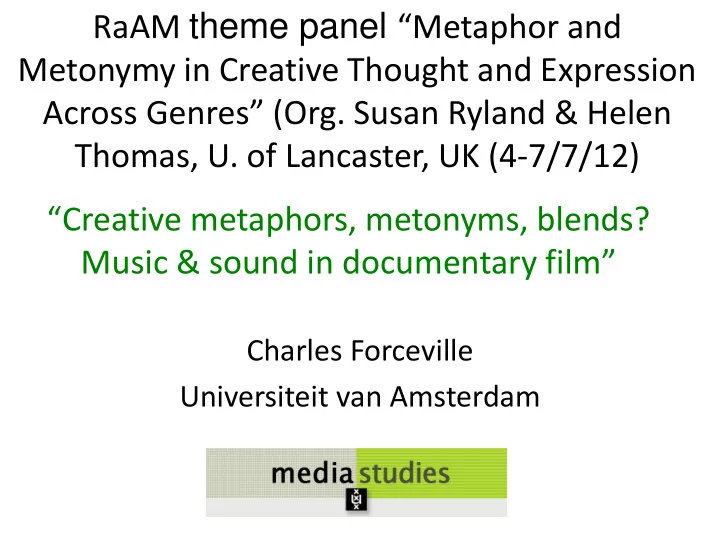

RaAM theme panel “Metaphor and Metonymy in Creative Thought and Expression Across Genres” (Org. Susan Ryland & Helen Thomas, U. of Lancaster, UK (4-7/7/12) “Creative metaphors, metonyms, blends? Music & sound in documentary film” Charles Forceville Universiteit van Amsterdam
Background assumptions 1 • In order to meet its claim that humans “think metaphorically,” CMT scholars need to engage with (cognitivist) scholars studying music, film and other non/partly-verbal discourses. • Music in film contributes to overall meaning, in combination with visuals and language (Klumperbeek 2012). It can be used to reinforce meaningful information in these other modalities, but also function contrapuntally , i.e., it can unexpectedly evoke elements of meaning that are not, or only latently, present in the visual and/or verbal track.
Background assumptions 2 • Barthes (1964) calls the reinforcing of visuals by verbal information “anchoring” and their complementing “ relaying.” • How to distinguish them? • Forceville 1996: – There is a continuum between anchoring and relaying; – In principle, information in each modality can anchor/relay information in any other modality.
Big Question Does it make sense to discuss contrapuntal relations between the visual and the musical track in films in terms of (creative) metaphors, metonymies, or blends?
Creative Metaphor, Metonymy, Blend Creative metaphor : A is B, in which B triggers unexpected mappings to A (A and B belong to different domains). Creative metonymy : B for A, in which B focuses attention on unexpected dimensions of A (A and B belong to the same domain). Creative blend: Blend Z is the result of input spaces A and B (and C …) democratically (versus metaphor), each contributing unique relevant properties to Z (A, B, C belong to different domains).
Example 1 (from Coal Face , Cavalcanti UK 1935) Coal Face 2 fragments 2'.avi
Coal Face : Discussion • In the first fragment with the dramatic music accompanying the images of the miners, do we construe a metaphor MINERS ARE ADVENTURERS? INTERESTING INDIVIDUALS? Others? • In the 2 nd fragment, do we construe metaphor RUNNING TRAINS IS MILITARY OPERATION? • Do we understand the music as metonymically “picking out” or “anchoring” visual features? • Or do we merge the visual/musical/verbal “input spaces” into one “creative blend?” • Or do we do none of these things?
Example 2 (from Nuit et Brouillard, Resnais, France 1955) Nuit et Brouillard 2 fragments 1'30''.avi
Nuit et Brouillard : Discussion • “[T]he string orchestra serves to ‘populate’ the empty landscape in the prelude” (Dümling 1998). By contrast, the solo instrumentation accompanying the marching soldiers arguably focuses on the individuality of the soldiers. • Metonym “FULL” MUSIC for CORPSE-RIDDEN BUT EMPTY LANDSCAPE? “PIZZICATO” for INDIVIDUALITY? • Distorted “Deutschland, Deutschland über alles” (Hanns Eisler). Metonym for false triumphalism?
Example 3 (Opening from Berlin , Ruttman Germany 1927, 2 versions) 2x Opening Berlin.avi
Berlin: Discussion • Both versions “anchor” (or metonymically zoom in on) the visual rhythms. • Suggested difference: Second version cues urgency, threat more than first version (?).
Concluding thoughts 1 • Music & sound can be used creatively to zoom in on “hidden” elements in image. This meaning mainly (?) arises in conjunction of music/sound & image/language and may work slightly differently for different viewers. – “Miners are heroic and interesting people” ( Coal Face ); – “Empty landscape is ‘full’ of (memories of) dead bodies” ( Nuit et Brouillard ); – “Germany should not be proud but ashamed of itself” ( Nuit et Brouillard ); – “Train-to-Berlin” is a rhythmic (i)/ rhythmic-cum- threatening (ii) metonym for the city of Berlin” ( Berlin ).
Concluding thoughts 2 • When a musical theme (eg “anthem”) or sound (eg barking” or “alarm”) unambiguously cues a source domain an IMAGE/TEXT-IS-MUSIC/SOUND metaphor is possible. • We are often unaware of music, and presumably do not verbalize it, which makes it difficult to draw on CogLing concepts to describe metaphor, metonymy or other tropes drawing on music/ sound; they can at best account for some sonic effects in films.
Concluding thoughts 3 • Does it make sense to discuss all this in terms of (creative) metaphor, metonymy, blend – or oxymoron, antithesis, or yet other tropes? Well, what does seem to happen is that the soundtrack draws attention to (latent) features in the image or language track. • Blending Theory (allowing for more than two input spaces) & Relevance Theory hold promise, but … • … in the case of a bad fit between data and model, it is crucial to adapt the model!
Adventures in Multimodality (AIM) blog: http://muldisc.wordpress.com/ 15
Bibliography • Albrecht Dümling, Albrecht (1998 [1993)). “Eisler’s Music for Resnais’ ‘Night and Fog’ (1955); a musical counterpoint to the cinematic portrayal of terror.” Historical Journal of Film, Radio and Television 18(4): 575-84. • Klumperbeek, Benjamin (2012). Tropical Figures in the Assassin Film: How Metaphor and Other Tropes in Film Sound and Music Create Moral Allegiance. MA thesis Media & Culture, University of Amsterdam, NL.
Recommend
More recommend